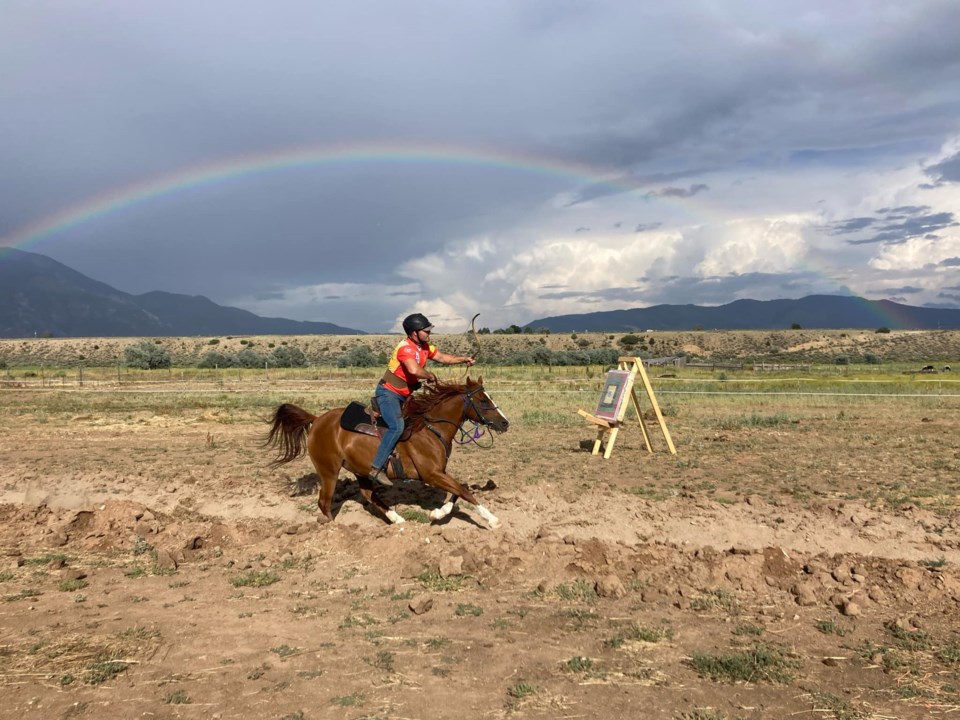YORKTON - Riding a hard charging horse is a skill all its own.
Drawing a bowstring to lose an arrow to hit a target is assuredly a very different skill.
Now imagine combining the two and you have the sport of horse archery, something that has participants worldwide, with roughly 200 practitioners in Canada (10-times that in the U.S.) Lance Bishop and Sarah Clarke from Nova Scotia among those. (There is a Canadian Federation of Mounted Archery.) The duo recently competed in the World Horseback Archery Federation World Cup Qualifier held in Taos County, New Mexico.
“I took the plunge,” Bishop told Yorkton This Week when asked which of the two had started first in the sport.
Clarke said she was eager to follow as the sport appealed to her inner desire “to be an Amazon warrior,” adding the whole process started from a random posting about the sport on Facebook.
“I didn’t know horseback archery was a thing,” said Bishop. “. . . I didn’t think it was even possible.”
But that quickly changed.
“We were super into it right away,’ said Clarke.
It was an interesting journey, especially for Bishop who didn’t have the basic skill set needed.
“Back then I didn’t ride horses,” he explained, adding “I was pretty good at archery from the age of five.”
By the time they discovered horse archery Bishop was almost 40 and “looking for what to do for fun.”
With the seed of interest in horse archery planted Bishop hit Google and learned the sport, which is rooted in the traditions of many cultures, was adapted into a modern sport largely by Lajos Kassai in Hungary.
According to Wikipedia “Kassai created the competitive rule system of horse archery in the late 1980s, and started to propagate this new sport, first in Hungary, and from the 1990s in the rest of Europe, the United States and Canada.
“He founded the center of Hungarian horse archery, Kassai-völgy, near Kaposmérő."4 Horse archery centers based on the Kassai school are currently operating in fourteen countries, and organize world cups regularly.”
For Bishop discovering Kassai’s efforts led him to journey to Hungary to learn from the master.
Bishop, a trail guide in N.S., said in Hungary horse archery has a very cultural connection, adding everyone there thinks “they are descendants of Attila the Hun.”
By the time he went overseas Bishop had ridden a horse.
“But I was not an educated rider,” he said, adding it sort of played in his favour as he rarely rode with a saddle, “so I had pretty good balance” which is foundationally important when shooting a bow off a moving horse.
That said, having been a standing archer for years was less foundational.
“The archery part is very different technically on a horse . . . than what the rest of us learn about archery on the ground,” said Bishop.
For example you can’t take your eyes off a target to knock an arrow because you lose site of the target on a moving horse so easily.
The archer is also looking to time the shot with the brief moment the horse has all four legs in the air as that provides the most stable shooting base.
“It’s a pretty brief moment that comes around every half second on a slow horse,” said Bishop, who now teaches horseback archery to beginners.
And then there is developing a partnership with your mount.
“To have a kind of relationship with the horse is a bigger journey,” said Bishop.
To start with there’s the sound of a whirring arrow going past their ears.
“They don’t like it,” said Bishop.
And normally a horse – especially ridden at speed – has the rider in control via reins in-hand. You can’t hold reins and shoot a bow.
Adding to the ride is that when shooting archers stand.
“There’s kind of a big leap of faith its going to be OK, (without reins in-hand),” said Bishop, adding that goes for both the rider and horse having to build trust without reins in play.
It eventually comes down to needing to almost “forget about the horse” and trust the relationship so the archer can focus on shooting the bow, he said.
With the basics learned horse archers then take to courses to shoot. While there are a variety of disciplines worldwide three are most widely known and practiced.
The first has a horse running a straight line with a directional target in the middle, the archer shooting at it as they approach, draw broadside, and then backward off the horse moving away from the target.
The second has horses on a similar straight line run, with a number of targets from about 10 to 50 metres away to shoot at. The best rider gets off about 12 arrows, hitting with each, noted Bishop, adding he is best shooting eight or nine, and focusing on technique.
The third is most demanding as it takes horse and rider cross country with water to cross, jumps to clear, and of course targets to hit.
At present there are participants from around the world with some of the best from Hungary, Korea, France and Mongolia, said Bishop adding all three disciplines are shot at world events.
There are also four major world organizations for the sport, all with at least one commonality, said Bishop, that being to see the sport in the Olympics one day.
For more information check out www.canadianfederationofmountedarchery.ca






